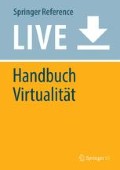Zusammenfassung
Um mittel- und langfristig autonome Systeme in unserer Gesellschaft und dem gemeinsamen Miteinander zu etablieren, bedarf es Konzepte, um die gültige Gesetzes- und Normenwelt sowie ein Verständnis über die Naturgesetze innerhalb dieser Systeme abzubilden. Moderne Lernverfahren zur Ausbildung künstlicher Intelligenzen stellen für eine Vielzahl von Anwendungen bereits geeignete Ansätze bereit. Für kritische Anwendungen, wie das autonome Fahren oder die kollaborative Arbeit ist jedoch das Erlernen im realen Einsatz undenkbar. Einen Lösungsansatz bieten die Virtualisierung und die Abbildung einer virtuellen Autonomie.
Literatur
„Autonome Systeme: Chancen und Risiken für Wirtschaft, Wissenschaft und Gesellschaft.“ 2016. Zwischenbericht.
Allen, Colin. 2010. Artificial life, artificial agents, virtual realities: technologies. In The Cambridge handbook of information and computer ethics, Hrsg. v. Luciano Floridi. 1. publ, 219–233. Cambridge: Cambridge University Press.
Bostrom, Nick. 2014. Superintelligence: Paths, dangers, strategies, 1. Aufl. Oxford: Oxford University Press.
Brooks, Rodney A. 1990. Elephants don’t play chess. Robotics and Autonomous Systems 6(1–2): 3–15. https://doi.org/10.1016/S0921-8890(05)80025-9.
Corten, Emiel, Leo Dorst, und Ben Kröse. 1998. OASIS: Open architecture for simulations with intelligent systems. In Intelligent autonomous systems IAS-5, Hrsg. Y. v. Kakazu, M. Wada und T. Sato, 6–12. Amsterdam: IOS Press.
Finn, Chelsea, und Sergey Levine. 2016. Deep visual foresight for planning robot motion. CoRR. abs/1610.00696.
Gallope, Michael. 2012. The sound of repeating life: Ethics and metaphysics in Deleuze’s philosophy of music. In Sounding the virtual: Gilles Deleuze and the theory and philosophy of music, Hrsg. Brian v. Hulse und Nick Nesbitt, 77–102. Farnham: Ashgate.
Gu, Shixiang, Ethan Holly, Timothy P. Lillicrap, und Sergey Levine. 2016. Deep reinforcement learning for robotic manipulation. CoRR. abs/1610.00633.
Herrera, Rodolfo R., und Leslie V. Rodríguez Quiñones. 2012. Reinforcement learning model for virtual pets. International Journal of Advanced Research in Computer and Communication Engineering 9(1): 733–736.
Malpas, Jeff. 2008. The non-autonomy of the virtual: Philosophical reflections on contemporary virtuality. Ubiquity 2008: Art. Nr. 4. 1–5. https://doi.org/10.1145/1378358.1378359.
Mnih, Volodymyr, Koray Kavukcuoglu, David Silver, Andrei A. Rusu, Joel Veness, Marc G. Bellemare, Alex Graves, et al. 2015. Human-level control through deep reinforcement learning. Nature 518(7540): 529–533.
Moravec, Hans P. 1988. Mind children: The future of robot and human intelligence. Cambridge, MA: Harvard University Press.
Paradowski, Michal B. 2011. Developing embodied multisensory dialogue agents. CoRR. abs/1111.7190.
Patzig, Günther. 1994. Grundlagen der Ethik, Gesammelte Schriften, Bd. 1. Göttingen: Wallstein.
Pfeifer, Rolf, und Christian Scheier. 2001. Understanding intelligence. Cambridge: MIT Press.
Russell, Stuart J., und Peter Norvig. 1995. Artificial intelligence: A modern approach, Prentice Hall series in artificial intelligence. Upper Saddle River: Prentice Hall.
Silver, David, Aja Huang, Chris J. Maddison, Arthur Guez, Laurent Sifre, George van den Driessche, Julian Schrittwieser, et al. 2016. Mastering the game of go with deep neural networks and tree search. Nature 529(7587): 484–489.
Sombetzki, Janina. 2016. Roboterethik. In Zur Zukunft der Bereichsethiken – Herausforderungen durch die Ökonomisierung der Welt. Schriftenreihe des Zentrums für Technik- und Wirtschaftsethik am Karlsruher Institut für Technologie, Hrsg. Matthias v. Maring, Bd. 8, 355–380. Karlsruhe: KIT Scientific Publishing.
Stangl, Werner. 2016. Autonomie: Psychologische Begriffsbestimmungen. http://www.stangl.eu/psychologie/definition/Autonomie.shtml. Zugegriffen am 02.12.2016.
Turing, Alan M. 1950. Computing machinery and intelligence. Mind 59(236): 433–460.
Yahya, Ali, Adrian Li, Mrinal Kalakrishnan, Yevgen Chebotar, und Sergey Levine. 2016. Collective robot reinforcement learning with distributed asynchronous guided policy search. CoRR. abs/1610.00673.
Author information
Authors and Affiliations
Corresponding author
Editor information
Editors and Affiliations
Rights and permissions
Copyright information
© 2019 Springer Fachmedien Wiesbaden GmbH, ein Teil von Springer Nature
About this entry
Cite this entry
Meisen, T., Adler, K., Thiele, T., Jeschke, S. (2019). Virtuelle Autonomie. In: Kasprowicz, D., Rieger, S. (eds) Handbuch Virtualität. Springer VS, Wiesbaden. https://doi.org/10.1007/978-3-658-16358-7_16-1
Download citation
DOI: https://doi.org/10.1007/978-3-658-16358-7_16-1
Received:
Accepted:
Published:
Publisher Name: Springer VS, Wiesbaden
Print ISBN: 978-3-658-16358-7
Online ISBN: 978-3-658-16358-7
eBook Packages: Springer Referenz Sozialwissenschaften und Recht

